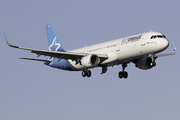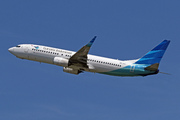Dépêches
Fitch Affirms JetBlue's IDR at 'B-'; Outlook Negative
Dépèche transmise le 4 juin 2009 par Business Wire
CHICAGO--(BUSINESS WIRE)--Fitch Ratings has affirmed the Issuer Default Rating (IDR) for JetBlue Airways Corp. (JBLU) at 'B-'. Fitch has also revised the issue rating for JBLU's $301 million of outstanding convertible debentures to 'CC/RR6' from 'CCC-/RR6'. The revision of the convertible debt rating follows recent changes in Fitch's notching criteria for issuers with IDRs of 'B-' or below. Fitch has also assigned a rating of 'CC/RR6' to JBLU's newly issued $175 million two-part convertible debenture offering. The new notes carry a coupon of 6.75% with a final maturity in 2039. The Rating Outlook for JBLU remains Negative.
The rating affirmation reflects Fitch's expectations that JBLU is in a position to deliver improved, but still negative, free cash flow in 2009, creating a stronger foundation for stable liquidity as the recession continues to pressure the airline industry revenue outlook while jet fuel prices remain volatile. Factoring in further weakness in passenger unit revenue comparisons stretching into the second half of the year, forecasted year-over-year fuel cost savings of over $400 million this year put JBLU in a position to report better free cash flow based on recent reductions in the airline's 2009 capital spending plan. The convertible debt and equity offering now being finalized, which could generate total cash proceeds of approximately $300 million, provides JBLU with additional liquidity to comfortably fund the anticipated repurchase of $177 million in outstanding 3.75% convertible debentures which holders can put back to the company next March.
The 'B-' IDR also captures the fact that the airline's risk profile has been altered significantly over the last two years as capacity rationalization and fleet plan adjustments have lowered capex to a level more consistent with the carrier's long-term cash generation and margin potential. In addition, the aircraft financing burden has been cut significantly following a number of aircraft delivery deferrals, sales, and lease deals completed over the past three years. Fitch views the carrier's more manageable fleet plan as an important credit positive as JBLU and its competitors struggle to balance capacity with demand during a period of continuing economic weakness.
The deterioration of the demand and fare environment that appeared to accelerate in the first quarter, before moderating somewhat in April, remains a major source of concern for JBLU and the entire industry. Given the need to generate improved free cash flow this year, and in light of recent increases in crude oil and jet fuel prices to six-month highs, a return to neutral or positive revenue per available seat mile (RASM) comparisons by the end of the year is critical. Importantly for JBLU, the carrier's route network is somewhat insulated from the collapse in passenger unit revenue (RASM) seen in premium business markets. As a result, JBLU's RASM performance has exceeded that of its U.S. competitors during the last two difficult quarters, and Fitch expects this trend to continue through the remainder of the year. JBLU's international network, while growing quickly in the Caribbean and Latin America, is still small relative to the U.S. legacy carriers. This has helped JBLU weather the downturn better, given its heavy exposure to leisure-oriented domestic markets, which have generally seen less intense RASM pressure following significant capacity reduction carried out during 2008. Improved ancillary revenue streams, tied to the roll-out of new fees and services over the last year, should help mute the passenger RASM effect this year, driving a larger gap between passenger RASM and total RASM performance.
Taking into account a weak demand picture and continuing fare sale activity, management indicated on May 21 that it expected second quarter-passenger RASM to decline by 6% to 9% (four points worse than previous guidance). The H1N1 flu outbreak has pressured demand further in affected areas of Mexico. While JBLU's direct revenue exposure to Mexico is very small (Cancun is the only market served), broader flu-related demand effects were seen in May unit revenue results, as some other U.S. carriers have recently noted. In addition, competitive fare pressure in trans-continental markets seems to be affecting RASM comparisons in those markets particularly hard.
JBLU reported that May passenger RASM declined by 10% year over year. This result was significantly better than that seen elsewhere in the industry (Continental and US Airways). However, the declines seem to suggest that a stabilization of deteriorating passenger yield trends is not yet occurring. As a result, a continuation of downside revenue risks remains the primary factor leading Fitch to keep the Rating Outlook at Negative.
With few signs of a rapid improvement in macroeconomic fundamentals, Fitch expects the period of negative RASM comparisons to continue through the peak summer demand period, raising the risk of material declines in full-year passenger RASM of 5% or more. In this scenario, JBLU could deliver a full-year operating profit absent a further spike in energy costs, but full-year positive free cash flow will be difficult to deliver if soft revenue trends continue.
The collapse in crude oil and jet fuel prices since last summer's peak has given JBLU a large cost savings opportunity this year, despite the recent jump in crude oil prices to above $65 per barrel. Based on the mid-April energy futures curve, management guided to full-year cash savings of over $600 million. This factors in the reduction of cash collateral tied to out-of-the-money fuel derivatives. Collateral held by hedging counterparties stood at $63 million as of March 31, and the balance is expected to approach zero in the second half of the year. JBLU unwound most energy swap contracts last fall. As of mid-April, 8% of remaining 2009 fuel exposure had been hedged. At that time, management expected jet fuel prices to average about $1.90 per gallon for the full year. In early June, JBLU indicated that it had added 5% to fuel hedge coverage beginning in the fourth quarter of 2009 and extending through 2010.
Rising non-fuel unit costs this year will offset some of the fuel-related savings. Much of the expected 9% increase in non-fuel cost per available seat mile (CASM) is linked to capacity cuts and reduced average stage lengths driven by route network changes. However, significant pressure on unit maintenance costs will continue as the JBLU fleet ages and more Airbus A320 aircraft undergo heavy maintenance checks. During the first quarter, unit maintenance costs rose by 19%.
Liquidity conservation remains one of management's top financial objectives in light of the stressed industry operating environment and the tightness of global credit markets. As of March 31, JBLU reported unrestricted cash and investments of $634 million, up from $561 million at year-end 2008. The airline has no long-term bank credit facility in place, but has tapped two short-term credit lines (UBS and Citigroup as lenders), collateralized by the company's largely-illiquid auction-rate securities (ARS). JBLU also has access to a borrowing facility that is used to finance aircraft pre-delivery deposits. Fitch views management's target of an unrestricted cash and investments balance in the range of 20% of trailing 12-months revenue (approximately $650 million) as an important level in light of JBLU's need to meet a heavier debt maturity schedule next year. The effective pre-funding of the $177 million balance of the 375% convertible debentures with total cash proceeds of over $250 million establishes an improved cash cushion for JBLU in the event that free cash flow trends fail to improve meaningfully as a result of weak operating conditions continuing into 2010.
Monetization of ARS will remain a liquidity priority following the lock-up of ARS markets in 2008. As of March 31, JBLU reported $207 million of ARS on its balance sheet (classified as long-term assets). JBLU has two credit lines collateralized by its ARS holdings - a Citigroup facility ($74 million drawn of $84 million available at March 31) maturing in April 2010 and a $53 million loan from UBS maturing in June 2010.
The 'RR6' Recovery Rating for JBLU's convertible debentures reflects expected recoveries of less than 10% for holders in a default scenario. The carrier's debt structure is primarily secured, and virtually no unencumbered assets are available to support future secured borrowings. In light of reduced aircraft capital commitments and more limited financing requirements in 2010, JBLU's total debt and leverage profile will likely remain relatively unchanged even in the absence of a sharp recovery in operating cash flow over the next year.
A downgrade to 'CCC' could follow if JBLU's unrestricted liquidity, adjusting for the expected repurchase of the 3.75% convertible notes next March, approaches $500 million at year-end with no evidence of a recovery in demand, yields, or RASM late in the year. Alternatively, a revision of the Rating Outlook to Stable could result if passenger demand and RASM trends begin to improve materially, increasing the likelihood of a swing to positive free cash flow in 2010.
Fitch's rating definitions and the terms of use of such ratings are available on the agency's public site, www.fitchratings.com. Published ratings, criteria and methodologies are available from this site, at all times. Fitch's code of conduct, confidentiality, conflicts of interest, affiliate firewall, compliance and other relevant policies and procedures are also available from the 'Code of Conduct' section of this site.
- 21:28 Friedrichshafen 2024 : le projet "Fly The North"
- 16:52 Friedrichshafen 2024 : Aura Aero présente pour la première fois ses trois appareils
- 16:25 Friedrichshafen 2024 : Duc Hélices présente son hélice Tiger-3
- 15:33 Friedrichshafen 2024 : Splash-in Aviation expose son Pétrel X
- 07:25 Friedrichshafen 2024 : Robin "toujours présent et pour longtemps"
- 07:11 Friedrichshafen 2024 : Beringer présente au salon
- 07:01Friedrichshafen 2024 : la FFPLUM dément le passage de tous les ULM 3 axes à 600kg
- 06:44 Friedrichshafen 2024 : visite d'un Pilatus PC-12 (photos)
- 17/04 Friedrichshafen 2024 : Cirrus Aircraft présente son SR G7
- 17/04 Friedrichshafen 2024 : Piper présente son M700 Fury
- 17/04 Friedrichshafen 2024 : Junkers dévoile son A50 Heritage
- 17/04 Friedrichshafen 2024 : la société E-Props présente au salon
- 17/04 Le 30e salon de Friedrichshafen a ouvert ses portes
- 15/04 Airbus : commandes et livraisons de mars 2024
- 15/04 easyJet renforce ses dessertes depuis la France vers Budapest
- 15/04 Vueling inaugure sa liaison entre Orly et Heathrow
- 12/04 British Airways ouvre les candidatures pour son programme cadets Speedbird Pilot Academy
- 12/04 Icelandair et Expedia annoncent un nouveau partenariat
- 12/04 Turkish Airlines : résultats 2023
- 12/04 easyJet annonce deux nouvelles lignes depuis Lyon







